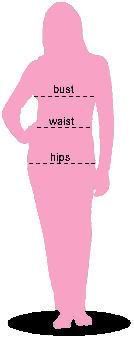Tip: When measuring keep the tape comfortably loose :)
Size | Bust | Waist | Hips |
1X | 40-42" | 38" | Up to 52" |
2X | 42-44" | 40" | Up to 54" |
3X | 44-46" | 42" | Up to 56" |
4X | 46-48" | 44" | Up to 58" |
5X | 48-50" | 46" | Up to 60" |
Buying online should never be scary...
Shopping anywhere should always be fun!
On every item, you will find exact measurements (often in a size chart). Please use this chart as a guide and compare measurements listed to those of your own (or compare to measurements of items in your closet in which you love the way it fits you).
We try our best to help you get the right fit each and every time!
Did you know?
Not all sizes are created equal. Sizing standards vary from manufacturer to manufacturer. For one, a 1X top could actually measure up to a 3X.
That is why it's important to pay close attention to each item's exact measurements. Hint: your bra size is not your bust size.
How do you get the right fit?
Please use the guidelines below when measuring for our clothing:
 | Bust Waist Hips |
How to Measure a Top You Have:

*Lay the top flat as show
*Using a measuring tape, measure the following without stretching the fabric:
(for example: 22" x 2 = 44" bust measurement)
→ Hips: measure at the hipline, then double
How To Measure Using Pants
To ensure the best fit, you’ll need to measure the pant's waist size, hip size, and inseam.
- Lay the pants on a flat surface, front side up.
- Waist - Measure the waistband of the pants from one side to the other, multiply that number by 2, (Example: 18" x 2 = 36" waist size)
- Hip - Determining where to measure the hips can be tricky. A general rule of thumb is to start at bottom of the zipper, then measure across the front and multiply that number by 2, (Example: 22" x 2 = 44" hip size).
- Inseam - Start at the anchor point in the crotch, and follow the seam on the inside of the leg down to where the leg ends.
About Fabric Content:
Fabric also plays a role in how a garment will fit.Here's a brief lesson on some of the most popular fabrics used in today's fashions:
* Rayon: Also knows as Viscose. Produced from naturally occurring polymers. Rayon/Viscose is a very versatile fiber and has the same comfort properties as natural fibers. It can imitate the feel and texture of silk, wool, cotton, and linen. Rayon/Viscose fabrics are soft, smooth, cool, comfortable, and highly absorbent, but they do not insulate body heat, making them ideal for use in hot and humid climates. It's actually more breathable than cotton! It also adds a great comfortable stretch blended with any fabric.
* Cotton: A natural and highly absorbent fabric mainly used for t-shirts, bed sheets, denim, and more. It is the least versatile fabric when used alone. However, it is sometimes blended with other fibers, including Rayon/Viscose, and synthetic fibers such as polyester to provide a better stretch.
* Polyester: The most widely used manufactured fiber in the U.S. Polyester fabrics may exhibit other advantages over natural fabrics, e.g., improved wrinkle resistance. As a result, polyester fibers are often spun together with other fibers to produce a cloth with blended properties. Depending on the blend, you can either get a soft, silky fabric or a more versatile cotton-feel fabric.
* Spandex: Known for it's incredible stretch. Great when blended with other fabrics for a more comfortable fit. It is lightweight, soft and smooth, and resistant to body oils, perspiration, lotions, and detergents.
If you need any assistance, please do not hesitate to contact us. We will be more than happy to work with you to ensure your purchase is fun, easy, and satisfactory.
Important:
Due to our clothing being sourced from many different manufacturing companies around the world the original sizing on the clothing tags may differ. Our charting correspond to the chart above. We want to ensure that you get exactly the right size for you :)

